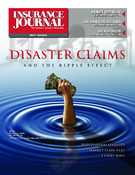Managing the risk of lawsuits against lawyers.
With more than a quarter million law firms in the United States, the lawyers’ professional liability market represents a huge opportunity for retail agents and wholesale brokers seeking to grow their business.
“In any given year, five to six practicing insured lawyers out of every 100 see a malpractice claim. Even good attorneys get sued and sued routinely. It doesn’t mean that they are bad lawyers because they come to surplus lines. It could be their practice area,” said Carol Murphy marketing manager for Shand Morahan and Co. to more than 1,200 registered agents across the country during the “How to Write” seminar broadcasted from the Insurance Journal Studios in San Diego.
The seminar, schooled by Shand’s Murphy and Mark Henderson, product manager for lawyers’ E&O, focused on lawyers’ professional liability. LPL is likely the most diverse line of business in the insurance industry, according to Murphy. The business represents a huge opportunity, adding up to about $1.5 billion to $2 billion worth of annual premiums. “While the lawyers’ errors and omissions market has experienced softening in rates recently, it still equates to a growth line for excess and surplus lines carriers,” Murphy said.
Law is a diverse field with legal services representing about 40 to 45 different areas of practice. Zapdata.com shows more than 252,000 law firms exist in the United States. Of those, approximately 60 percent practice in the private sector. The remaining 40 percent are involved in corporate, government or public sector work. Of the 60 percent in private practice, about 80 percent have less than 5 attorneys, and 40 percent work as sole proprietorships. That translates into a $2 billion marketplace with many small firms looking for coverage.
“The lawyers’ professional liability market has been affected by the same market conditions as other professional liability lines, but it hasn’t experienced the same turbulence as medical malpractice and directors and officers,” Murphy said. “During the last cycle, there were a number of companies that exited the LPL marketplace, and the choices are now similar to other professional liabilities, although bar-affiliated or bar-sponsored standard admitted carriers still exist for LPL. Many take coverages within a particular state or region with all the advantages of an admitted market with benefits to the guaranteed fund, no subjection to surplus lines tax, and standard rates and forms.”
Yet that can also create a disadvantage for an attorney who has an atypical practice. “Maybe there is some kind of form modification that needs to be made, or the underwriting criteria does not allow them to offer continued coverage. Those attorneys go to surplus lines companies as nonadmitted, where they have the ability to manuscript the endorsements and price the account in a way that makes sense to all the parties involved,” Murphy explained.
She added that approximately 15 to 20 companies offer lawyers professional liability. The majority are standard companies; just a few exist in the nonstandard arena.
Murphy identified three factors that can bring lawyers’ E&O risks to the excess and surplus lines markets: practice area, claims and disciplinary reasons. Plaintiff work, for example, accounts for about 25 percent of claims at Shand, she said. “If you indicate on a standard carrier’s application that you do class action work, they probably will not offer you terms. That will automatically put you into surplus lines.”
Intellectual property and patent practices often go into surplus lines as well. “They have probably been misunderstood. [Those markets] have been really good writes for us. We think that is a big opportunity for us to write in LPL,” she added. Later she mentioned entertainment and securities as other areas that often get bumped from a standard carrier to surplus lines.
When identifying risk characteristics of a potential law firm, Henderson said his company leans more toward firms with 5 to 20 attorneys on staff. “We like to see firms with more resources. By resources, we mean capital, computers, staff size, staff experience and just overall staying power. With all professionals increasingly challenged from a financial and economic standpoint, we feel firms with more staying power are less likely to cut corners and let standards go by the wayside.” He noted firms with less staying power might be more likely to take on marginal clients out of economic pressure. And that marginal clients are a higher risk to turn around and sue.
“Another thing we look at is how long the firm has been in operation,” Henderson added. “We like to see old line firms. Firms with a proven, successful track record become ever more attractive from an underwriting standpoint.” Another underwriting factor often overlooked is the firm’s locale. “Some states are more litigious than others,” he said.
When writing LPL, companies will look at the experience and the education levels of the attorney. Henderson said Shand keeps a list of the top 20 law schools, although he admited there are exceptions. “We know there are people who graduated from Harvard Law School who can’t find the courthouse. And there are those who have graduated from second tier law schools that are superstars.”
He also said his company examines the culture of a law firm because it creates an interesting dynamic that isn’t always readily identifiable, though more discernable in a difficult to place market. “Bad culture in a law firm is often identified in the sense that when you see claims there is always a superficial answer,” he said. They’ll say, “It wasn’t our fault; it was someone else’s fault.”
“When you look back, there is usually always a root cause in the firm that leads to a claim. From our underwriting standpoint, we try to identify what the real root cause is,” Henderson said. Many times, when a firm comes into the hard-to-place market, it can be the result of a dysfunctional culture, a dysfunctional culture within the ownership structure in the firm.
“You might have one partner who gets all the profits, keeping in mind that the goal for most laws school graduates is to get into a firm and eventually be able to make partner and share in the profits. If you feel you are not going to make partner, there is a low morale. We call these firms revolving doors. You’ll see one or two partners and a revolving door of associates who tend to be underpaid and overworked. They also have a revolving door of clients. So the culture is huge, and it tends to drive claims,” Henderson explained.
Other important claims-driving factors are systems and procedures. That includes the quality of the management of the firm. “It is incredibly important from an underwriting and risk management standpoint for a firm to have a qualified, full-time legal administrator,” Henderson said. “Generally a well-rounded individual with a broad skill set holds the firm together.” After that, it is important that the firm has sufficient systems and procedures in place to make sure things don’t get overlooked and to make sure the firm functions properly.
According to the American Bar Association, 94 percent of all firms are highly computerized and need to be to remain competitive. “Traditionally, the most important system has been a docket control system, which keeps track of dates by which a law firm has to file a lawsuit,” Henderson said.
Having the proper systems is the main concern regarding risk management, according to Henderson. “Computers are really the main thing … it takes away a lot of the human errors and oversights, which are the root causes of a lot of claims.”
Illustrating another large area of risk management for attorneys, Henderson mentioned client relationships. “This goes to how they interact with their client; keeping them up to date, keeping rapport and setting and managing realistic expectations.”
A lot of attorneys over promise and under deliver to land a client and get them to pay the retainer according to Henderson. Then when they can’t deliver, they set themselves up for a lawsuit. “It’s better to under promise and over deliver,” he said.
From an underwriting standpoint, Shand prefers to insure specialist firms or specialist attorneys. Most state bar associations encourage their members to specialize due to the complexity and constant evolving nature of practice areas. It’s difficult enough to be proficient in one area let alone a number of areas. “Over the years we’ve seen claims happen when an attorney gets out of his or her scope of expertise. This tends to be difficult from a claims handling standpoint to defend,” Henderson said.
The usual driving factor for this type of claim is economics. Smaller firms with low capital and staying power get pressured to make rent or make a profit. They are generally more vulnerable to stray outside of their core of competency according to Henderson.
Then there are generalist or dabbler attorney firms that will take any case or client–even if that client has sued his previous three attorneys.
Three big causes of claims, Murphy said, are: practice area with personal injury plaintiff work on top; corporate law with administrative errors and docket control at the head; and substantive errors (the failure to know the law.).
Practice area according to Murphy, “will probably always be the leader and has been since the American Bar Association started keeping track of this in the late 1980s.” Substantive errors, she said, “usually occur when an attorney is dabbling in something outside of his or her area of expertise.”
Some resources underwriters use at Shand when evaluating an application in-clude Web sites (i.e. Martindale-Hubble, Google, Yahoo!) and the local state bar association for disciplinary actions. They indicate who has recently gotten into trouble. Martindale-Hubble, a directory of law firms, rates attorneys and law firms. According to Henderson, those ratings have a lot of credibility because they are peer ratings. Surveyed are judges, fellow practitioners and opponent practitioners. The company then assigns a rating based on the consensus.
At www.lawyers.com, people can search for a firm name or locale, and find resumes of the firm with educational background included.
In California, the California Bar Association Web site is one of the best in the country for attorneys’ disciplinary proceedings, Henderson said.
To view the “How to Write Lawyers Malpractice Liability” seminar in its entirety, log on to www.insurancejournal.com/seminars for a link to free registration. To find out how to register for this or any of the seminars in the “How to Write Series,” e-mail Insurance Journal’s Media Producer, Chad Reese: creese@insurancejournal.com.
Topics Lawsuits Claims Excess Surplus Underwriting
Was this article valuable?
Here are more articles you may enjoy.


 Thumbs Down on SELF DRIVE Act as Written, Says Industry Trades
Thumbs Down on SELF DRIVE Act as Written, Says Industry Trades  AIG Announces Strategic Investment Partnership of Up to $3.5B With CVC
AIG Announces Strategic Investment Partnership of Up to $3.5B With CVC  Florida Lawmakers Ready for Another Shot at Litigation Funding Limits
Florida Lawmakers Ready for Another Shot at Litigation Funding Limits  Alliant Latest to Sue Howden US Over Alleged ‘Smash-and-Grab’ Poaching
Alliant Latest to Sue Howden US Over Alleged ‘Smash-and-Grab’ Poaching 


